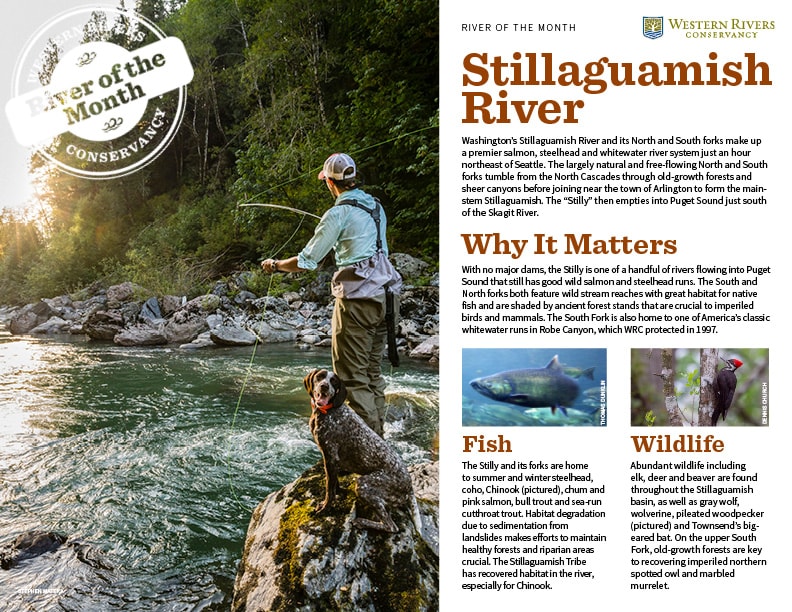
Fish
The Stilly and its forks are home to summer and winter steelhead, coho, Chinook (pictured), chum and pink salmon, bull trout and sea-run cutthroat trout. Habitat degradation due to sedimentation from landslides makes efforts to maintain healthy forests and riparian areas crucial. The Stillaguamish Tribe has recovered habitat in the river, especially for Chinook.

Wildlife
Abundant wildlife including elk, deer and beaver are found throughout the Stillaguamish basin, as well as gray wolf, wolverine, pileated woodpecker (pictured) and Townsend’s big-eared bat. On the upper South Fork, old-growth forests are key to recovering imperiled northern spotted owl and marbled murrelet.
-
Paddle
A bucket-list-destination for advanced (or insane, depending on your point of view) boaters, Robe Canyon is one of the most famous Class-V runs in the nation. The 12-mile trip begins gently enough at Verlot Campground, and then the Stilly roars for three extreme miles through the boulder-strewn canyon, where boaters navigate harrowing chutes and heart-pounding drops.
-
Fish
The Stilly ranks high on the list of Washington steelhead destinations, especially the North Fork, which was the world’s first stream to be designated fly-fishing only (in 1949). The South Fork, though less-often fished, offers up the occasional steelhead, with plenty of quiet holes above Granite Falls and into the National Forest. Cutthroat trout and coho are also popular.
-
Hike
Go back in time hiking an old railroad grade in Robe Canyon Historic Park via the Old Robe Canyon Trail or the Lime Kiln Trail, which both offer plenty of history and gorge views. For old-growth hikes, Gold Basin Campground is a good launch point. The Big Four Ice Caves area has great snowshoeing and, in June, some of the best bird-watching in the North Cascades.
The WRC Story
To preserve a cherished historic trail along the South Fork Stilly and a world-class whitewater run, Western Rivers Conservancy bought 880 acres from a timber company in beautiful Robe Canyon. After a seven-year effort, WRC and local partners at last cut the ceremonial ribbon on Robe Canyon Historic Park in 1997, when we conveyed the lands to Snohomish County. The project allowed local groups to protect a trail along an 1890s-era railroad grade, which passed through six rock tunnels that once carried gold from the nearby mining town of Monte Cristo. Thanks to our efforts, you can still see this piece of Northwest history for yourself. For boaters, the project also made access easier to Robe Canyon’s expert whitewater.
Upstream, we prevented logging and landslides near Gold Basin when we bought 360 acres in the 1990s. We transferred the lands to the surrounding Mount Baker-Snoqualmie National Forest to uphold fragile fish runs and preserve old-growth forests where marbled murrelet and Northern spotted owl take refuge.


Best Time of Year
- Trout fishing
- Aug-Nov
- Steelhead fishing
- Jun-Jul
- Whitewater
- Winter-spring (check flows)
- Hiking
- Spring-fall, with winter snowshoeing
Go Deeper
-
Traveling the Mountain Loop: 10 Great Places to Stop
(The Herald)
Learn More -
Annual Stillaguamish Festival of the River and Powwow
(Stillaguamish Trive)
Learn More -
Stillaguamish Hatchery to Double Release of Fall Chinook
(NW Treaty Tribes)
Learn More -
Exploring the Historic Train Canyon on Old Robe Trail (
(Fit Living Lifestyle)
Learn More -
Birding near the Big Four Ice Caves
(BirdWeb)
Learn More


